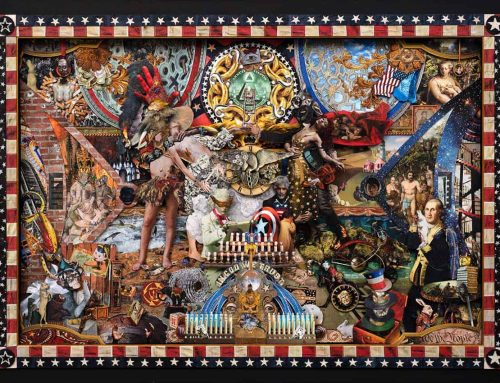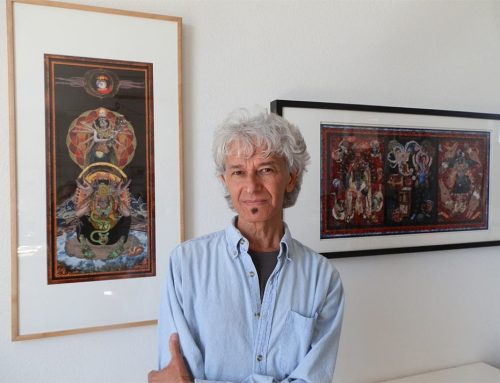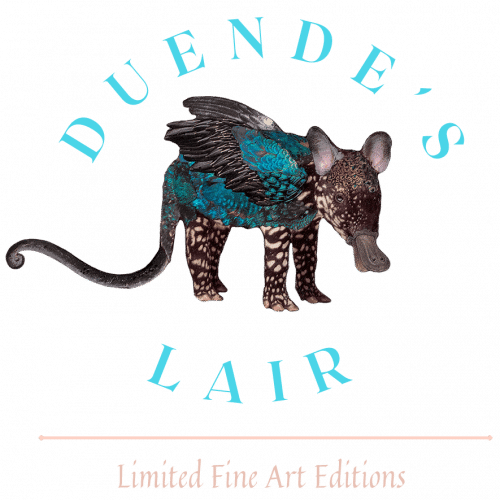Albuquerque Journal – Journal North
Pieces fall into place in seductive collages
By Ellen Berkovitch
The narcissistic eye performs as a compass in Carlos Quinto Kemm’s phantasmagoric expiations. The erotic extravagance of his collages leaves an afterglow, like star trails.
That the effect is innocent, magical and even touching, attests to the artist’s ability with a limited range of materials and to his very directed intention. Kemm gently removes icons of beauty and desirability from their context – the magazine – and inserts them into a world of idealized association that lets them operate on our subliminal yearnings.
If, as Kemm so properly understands, the visual image can transform and manipulate, it can also transform itself – and he reintroduces it to us, its varnish unchipped but illumination utterly altered: Whore unto Madonna, every time. The waif and the supermodel emerge from the surf like Botticelli’s “The Birth of Venus.”
“Saint Georgette,” for instance, is a voluptuous Brigitte Nielsen type, muscles rippling and forceful stance emanating unqualified confidence. All I can remember about Saint George, her apparent namesake, is that he slew a dragon.
What is clear is that Kemm intends for his collage to prod the viewer’s unconscious, as any decent myth does. In “Saint Georgette,” all the pictorial elements – her Darth Vader costume, the baby falling through the sky, the New York City skyline – add up to a visual dictionary of competing drives. There are cities to be conquered, and children to be borne. How ill Saint Georgette’s mastery manifest?
Every one of Kemm’s collages is an inducement to psychic time-travel. Splendiferous and funny, they apparently cause some viewers to fell. Other wonder why a “classy” gallery like LewAllen hangs them on its walls. (By the way, if you read the artist’s resume, you’ll learn that his collectors include Sly Stallone, and several museums. How’s that for image-busting?)
I love Kemm’s work; Fish fly; rock stars turn into kings and queens (or vice versa). The sumptuousness of detail manages not to interfere with cohesion. Joyfully absorbed in a sensory riot, one can see both the pieces and the whole.
Kemm is a native of Las Vegas, N.M., where he still lives. His biography at the gallery remarks on his love of reading as a child. The amount of time and undiluted concentration he must now commit to pouring over magazines and printed material is astonishing. He searches media until he finds a “pure” image uncorrupted b the “pollution” that he believes proliferates.
In many respects his attitude and output recalls the artist Joseph Cornell who, though a recluse living at home with his mother and addled brother, use do go to Broadway and look at the theaters where the big stars performed. He was, in a word, star-struck. Remembering that the definition of star-struck encompasses both the celestial and the material, it is apt to Kemm as well.
The sensory glut he handles is magnificent and even sometimes, a little frightening. It is clever: This artist clearly knows his art history, and if you get it too, you may howl to see the manner in which modernism meets art historical precedents: de Stijil, the Renaissance, Impressionism, Surrealism, Kemm claims to be inspired by Moghul miniatures; and the collages emanate a certain Byzantine quality amid psychedalia.
It took Kemm five years to produce the body of work on display here. Initially, he derived all his images by cutting up magazines, but when he grew bored with the lack of tactile involvement, he began coating the surfaces of the clippings with gel to create surfaces for paint and inks. Now, by applying clear gel to the clippings and then layer on successive degrees of color, he creates elaborate depth illusions.
Kemm’s work made me remember the cult movie, “Paris Is Burning,” Jennie Livingston’s documentary about New York City drag queens. Where in Livingston’s film, the “ball” is the local art event – the arena for self-expressionism, outrageous celebration and social transformation – Kemm’s collages produce a similar, stunning effect.
In “Paris,” one marvels at how the drag queens can come up with such elaborate constructions using such limited means – and taking in Kemm’s work, one marvels, also, at his fluency with so few materials.
I once heard the writer Tom Wolfe quip, in a talk about magazines, “I don’t read them, I eat them.” Graphic designers command hundreds of thousands of dollars for creating strong visual identities and visual languages that advertisers use to exploit consumer appetites. One of the tools of this blank slate is, in the jargon, “seamless” – a “seamless” fabric against which fashion models or portrait subjects are photographed; a “seamless” ad campaign that conveys its message across myriad printed pages and situations.
With this in mind, it becomes all the more instructive to consider Kemm’s work as an energetic reestablishment of the seam. In my opinion, his collage surely fulfills the exigencies of “beauty,” which critic Dave Hickey has laid out; although, in a seeming but not actual contradiction, other might say that Kemm’s beauty encompasses two parts vulgarity and exhibitionism.
Yet it is way too simple to assign these a high kitsch quotient and end the conversation there. In a tough that I love, Kemm alters some of the clippings he uses with a hole-punch. This is a great idea when you consider that he is punching holes in something that is only surface, anyway, yet manipulating our perception of it by what he lays behind it as a doppelganger, or shadow self.
In “El Amor Brujo,” one of my favorite collages, the holes reveal scenes from Hieronymous Bosch’s “Garden of Earthly Delights.” The composition of the whole suggests Henri Rousseau’s “The Sleeping Gypsy,” Which pictures and Arab sleeping on the desert floor under a full moon, a lion standing over him.
There is so much dazzle here that one’s eyes may tire, traveling the whole room. Yet what ultimately makes this work so strong is its inducement to action and physical joyousness. Kemm’s limpid, animated world celebrates the particulate matter and energy of life. The artist must exhaust himself delving into his own psychic trove for these gems. He invigorates us with their power.







